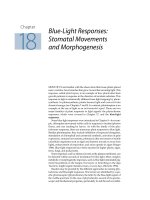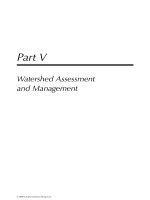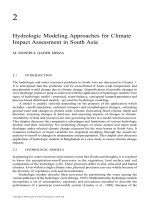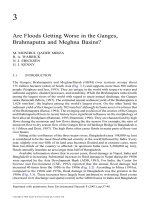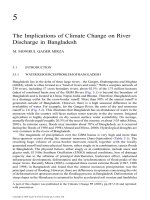OB11 chapter 18 organizaional change and stress management
Bạn đang xem bản rút gọn của tài liệu. Xem và tải ngay bản đầy đủ của tài liệu tại đây (652.36 KB, 46 trang )
eleventh edition
organizational
behavior
stephen p. robbins
Chapter 18
Organizational Change
and Stress Management
ORGANIZATIONAL BEHAVIOR
S T E P H E N P. R O B B I N S
E L E V E N T H
© 2005 Prentice Hall Inc.
All rights reserved.
E D I T I O N
WWW.PRENHALL.COM/ROBBINS
PowerPoint Presentation
by Charlie Cook
OBJECTIVES
LEARNING
After studying this chapter,
you should be able to:
1. Describe forces that act as stimulants to
change.
2. Summarize the sources of individual and
organizational resistance to change.
3. Summarize Lewin’s three-step change model.
4. Explain the values underlying most OD efforts.
5. Contrast process reengineering and
continuous improvement processes
6. Identify properties of innovative organizations.
© 2005 Prentice Hall Inc.
18–
All rights reserved.
3
7. List characteristics of a learning organization.
8. Describe potential sources of stress.
9. Explain individual difference variables that
moderate the stress–outcome relationship.
LEARNING
O B J E C T I V E S (cont’d)
After studying this chapter,
you should be able to:
© 2005 Prentice Hall Inc.
All rights reserved.
18–4
Forces
Forces for
for Change
Change
Force
Examples
Nature of the workforce
More cultural diversity
Aging population
Many new entrants with inadequate skills
Technology
Faster, cheaper, and more mobile computers
On-line music sharing
Deciphering of the human genetic code
Economic shocks
Rise and fall of dot-com stocks
2000–02 stock market collapse
Record low interest rates
Competition
Global competitors
Mergers and consolidations
Growth of e-commerce
© 2005 Prentice Hall Inc.
All rights reserved.
E X H I B I T 18–1
E X H I B I T 18–1
18–5
Forces
Forces for
for Change
Change
Force
Examples
Social trends
Internet chat rooms
Retirement of Baby Boomers
Rise in discount and “big box” retailers
World politics
Iraq–U.S. war
Opening of markets in China
War on terrorism following 9/11/01
© 2005 Prentice Hall Inc.
All rights reserved.
18–
6
E X H I B I T 18–1 (cont’d)
E X H I B I T 18–1 (cont’d)
Managing
Managing Planned
Planned Change
Change
Change
Making things different.
Planned Change
Activities that are
intentional and goal
oriented.
Change Agents
Persons who act as
catalysts and assume the
responsibility for managing
change activities.
© 2005 Prentice Hall Inc.
All rights reserved.
Goals
Goalsof
ofPlanned
Planned
Change:
Change:
Improving
Improvingthe
theability
abilityof
of
the
theorganization
organizationto
to
adapt
adaptto
tochanges
changesininits
its
environment.
environment.
Changing
Changingthe
thebehavior
behavior
of
ofindividuals
individualsand
and
groups
groupsininthe
the
organization.
organization.
18–7
Resistance
Resistance to
to Change
Change
Forms of Resistance to Change
– Overt and immediate
• Voicing complaints, engaging in job actions
– Implicit and deferred
• Loss of employee loyalty and motivation, increased
errors or mistakes, increased absenteeism
© 2005 Prentice Hall Inc.
All rights reserved.
18–8
Sources
Sources of
of Individual
Individual Resistance
Resistance to
to Change
Change
© 2005 Prentice Hall Inc.
All rights reserved.
E X H I B I T 18–2
E X H I B I T 18–2
18–9
Sources
Sources of
of Organizational
Organizational Resistance
Resistance to
to
Change
Change
© 2005 Prentice Hall Inc.
All rights reserved.
18–
10
E X H I B I T 18–2 (cont’d)
E X H I B I T 18–2 (cont’d)
Overcoming
Overcoming Resistance
Resistance to
to Change
Change
Tactics
Tacticsfor
fordealing
dealingwith
withresistance
resistance
to
tochange:
change:
•• Education
Educationand
andcommunication
communication
•• Participation
Participation
•• Facilitation
Facilitationand
andsupport
support
•• Negotiation
Negotiation
•• Manipulation
Manipulationand
andcooptation
cooptation
•• Coercion
Coercion
© 2005 Prentice Hall Inc.
All rights reserved.
18–
11
The
The Politics
Politics of
of Change
Change
Impetus for change is likely to come from outside
change agents.
Internal change agents are most threatened by
their loss of status in the organization.
Long-time power holders tend to implement only
incremental change.
The outcomes of power struggles in the
organization will determine the speed and quality
of change.
© 2005 Prentice Hall Inc.
All rights reserved.
18–
12
Lewin’s
Lewin’s Three-Step
Three-Step Change
Change Model
Model
Unfreezing
Refreezing
Driving Forces
Restraining Forces
Change efforts to overcome
the pressures of both
individual resistance and
group conformity.
Forces that direct behavior
away from the status quo.
© 2005 Prentice Hall Inc.
All rights reserved.
Stabilizing a change
intervention by balancing
driving and restraining forces.
Forces that hinder movement
from the existing equilibrium.
18–
13
Lewin’s
Lewin’s Three-Step
Three-Step Change
Change Model
Model
© 2005 Prentice Hall Inc.
All rights reserved.
18–
14
E X H I B I T 18–3
E X H I B I T 18–3
Unfreezing
Unfreezing the
the Status
Status Quo
Quo
© 2005 Prentice Hall Inc.
All rights reserved.
18–
15
E X H I B I T 18–4
E X H I B I T 18–4
Kotter’s
Kotter’sEight-Step
Eight-StepPlan
Planfor
forImplementing
ImplementingChange
Change
1.
2.
3.
4.
5.
6.
7.
8.
Establish a sense of urgency by creating a compelling reason
for why change is needed.
Form a coalition with enough power to lead the change.
Create a new vision to direct the change and strategies for
achieving the vision.
Communicate the vision throughout the organization.
Empower others to act on the vision by removing barriers to
change and encouraging risk taking and creative problem
solving.
Plan for, create, and reward short-term “wins” that move the
organization toward the new vision.
Consolidate improvements, reassess changes, and make
necessary adjustments in the new programs.
Reinforce the changes by demonstrating the relationship
between new behaviors and organizational success.
© 2005 Prentice Hall Inc.
All rights reserved.
Source: Based on J. P. Kotter, Leading Change (Boston: Harvard Business School Press, 1996).
18–
16
E X H I B I T 18–5
E X H I B I T 18–5
Action
Action Research
Research
Action Research
A change process based on systematic collection of
data and then selection of a change action based on
what the analyzed data indicate.
Process
ProcessSteps:
Steps:
1.1. Diagnosis
Diagnosis
2.2. Analysis
Analysis
3.3. Feedback
Feedback
4.4. Action
Action
5.5. Evaluation
Evaluation
© 2005 Prentice Hall Inc.
All rights reserved.
Action
Actionresearch
researchbenefits:
benefits:
Problem-focused
Problem-focusedrather
rather
than
thansolution-centered.
solution-centered.
Heavy
Heavyemployee
employee
involvement
involvementreduces
reduces
resistance
resistanceto
tochange.
change.
18–
17
Organizational
Organizational Development
Development
Organizational Development (OD)
A collection of planned interventions, built on
humanistic-democratic values, that seeks to improve
organizational effectiveness and employee well-being.
OD
ODValues:
Values:
1.1. Respect
Respectfor
forpeople
people
2.2. Trust
Trustand
andsupport
support
3.3. Power
Powerequalization
equalization
4.4. Confrontation
Confrontation
© 2005 Prentice Hall Inc.
All rights reserved.
5.5. Participation
Participation
18–
18
Organizational
Organizational Development
Development Techniques
Techniques
Sensitivity Training
Training groups (T-groups) that
seek to change behavior through
unstructured group interaction.
Provides increased awareness of
others and self.
Increases empathy with others,
improves listening skills, greater
openess, and increased tolerance
for others.
© 2005 Prentice Hall Inc.
All rights reserved.
18–
19
Organizational
Organizational Development
Development Techniques
Techniques
(cont’d)
(cont’d)
Survey Feedback Approach
The use of questionnaires to identify discrepancies
among member perceptions; discussion follows
and remedies are suggested.
© 2005 Prentice Hall Inc.
All rights reserved.
18–
20
Organizational
Organizational Development
Development Techniques
Techniques
(cont’d)
(cont’d)
Process Consultation (PC)
A consultant gives a client insights into what is going
on around the client, within the client, and between
the client and other people; identifies processes that
need improvement.
© 2005 Prentice Hall Inc.
All rights reserved.
18–
21
Organizational
Organizational Development
Development Techniques
Techniques
(cont’d)
(cont’d)
Team Building
High interaction among team members to
increase trust and openness.
Team
TeamBuilding
BuildingActivities:
Activities:
• • Goal
Goaland
andpriority
prioritysetting.
setting.
• • Developing
Developinginterpersonal
interpersonalrelations.
relations.
• • Role
Roleanalysis
analysisto
toeach
eachmember’s
member’srole
roleand
and
responsibilities.
responsibilities.
• • Team
Teamprocess
processanalysis.
analysis.
© 2005 Prentice Hall Inc.
All rights reserved.
18–
22
Organizational
Organizational Development
Development Techniques
Techniques
(cont’d)
(cont’d)
Intergroup Development
OD efforts to change the attitudes, stereotypes, and
perceptions that groups have of each other.
Intergroup
IntergroupProblem
ProblemSolving:
Solving:
• • Groups
Groupsindependently
independentlydevelop
developlists
listsof
ofperceptions.
perceptions.
• • Share
Shareand
anddiscuss
discusslists.
lists.
• • Look
Lookfor
forcauses
causesof
ofmisperceptions.
misperceptions.
• • Work
Workto
todevelop
developintegrative
integrativesolutions.
solutions.
© 2005 Prentice Hall Inc.
All rights reserved.
18–
23
Organizational
Organizational Development
Development Techniques
Techniques
(cont’d)
(cont’d)
Appreciative Inquiry
Seeks to identify the unique qualities and special
strengths of an organization, which can then be built
on to improve performance.
Appreciative
AppreciativeInquiry
Inquiry(AI):
(AI):
• • Discovery:
Discovery:recalling
recallingthe
thestrengths
strengthsof
ofthe
theorganization.
organization.
• • Dreaming:
Dreaming:speculation
speculationon
onthe
thefuture
futureof
ofthe
the
organization.
organization.
• • Design:
Design:finding
findingaacommon
commonvision.
vision.
deciding
how
• Destiny:
Destiny:
deciding
howto
tofulfill
fulfillthe
thedream.
dream.
© •2005
Prentice
Hall Inc.
All rights reserved.
18–
24
Contemporary
Contemporary Change
Change Issues
Issues For
For Today’s
Today’s
Managers
Managers
How are changes in technology affecting the work
lives of employees?
What can managers do to help their organizations
become more innovative?
How do managers create organizations that
continually learn and adapt?
Is managing change culture-bound?
© 2005 Prentice Hall Inc.
All rights reserved.
18–
25



